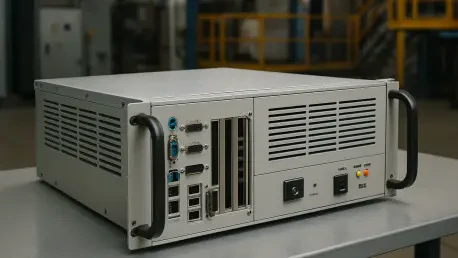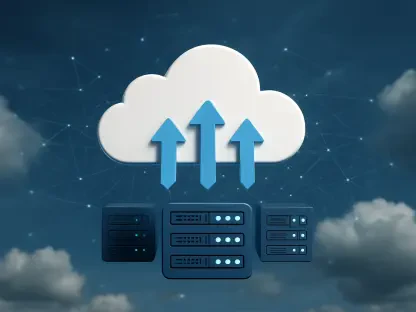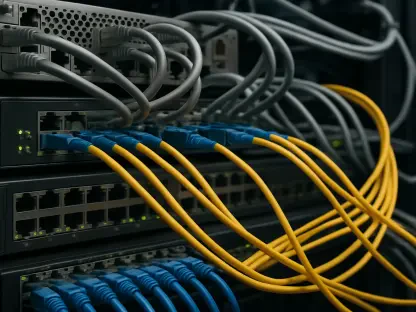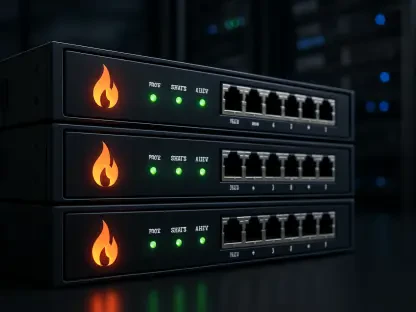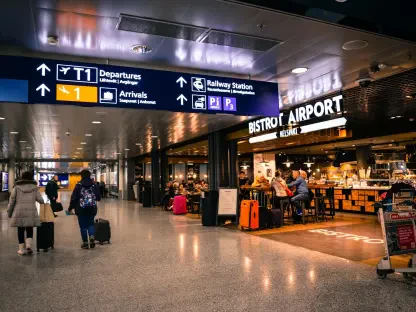In a world increasingly driven by digital transformation, the Box Type Industrial Computer Market stands out as a critical pillar of industrial innovation, with projections estimating a remarkable climb from $2,056.5 million in 2025 to an impressive $3.5 billion by 2035, reflecting a consistent compound annual growth rate (CAGR) of 5.4%. These rugged computing systems, designed to thrive in the toughest environments like manufacturing plants and energy facilities, are becoming essential as industries worldwide push toward automation and connectivity. Their ability to withstand extreme conditions such as dust, vibration, and temperature fluctuations makes them indispensable for sectors undergoing rapid technological shifts. This growth trajectory signals not just an expanding market, but a broader movement toward smarter, more resilient industrial operations. As the demand for reliable, high-performance solutions surges, this segment is poised to play a pivotal role in shaping the future of industrial computing over the next decade.
Forces Fueling Market Expansion
The momentum behind the growth of box type industrial computers is driven by several transformative trends reshaping industrial landscapes globally. A primary force is the escalating demand for automation, as industries strive to enhance productivity and efficiency through Industry 4.0 initiatives. These computers serve as the backbone of smart factories, enabling seamless integration of robotics and advanced control systems. Beyond automation, the proliferation of industrial Internet of Things (IoT) ecosystems is creating a pressing need for robust platforms that can handle vast data streams and facilitate real-time communication between devices. Such capabilities are vital for maintaining operational continuity in dynamic settings, positioning these systems as critical components in modern industrial networks. The intersection of automation and IoT underscores a fundamental shift toward interconnected, intelligent environments where reliability and speed are paramount.
Another significant driver is the rising importance of edge computing, which prioritizes processing data closer to its source to minimize latency and reduce dependence on centralized cloud systems. Box type industrial computers are uniquely suited for this role, offering the durability and performance needed for decentralized data management in harsh conditions. This trend is particularly impactful in sectors like transportation and utilities, where immediate data insights can optimize operations and prevent costly downtime. Additionally, the modernization of manufacturing in emerging economies is spurring investments in rugged computing solutions, as these regions seek to align with global standards of efficiency and innovation. Together, these dynamics paint a picture of a market propelled by both technological advancements and the practical demands of industrial environments striving for resilience and adaptability.
Regional Variations in Growth
Geographically, the market for box type industrial computers reveals distinct patterns of adoption and expansion across different regions. North America holds a dominant position, thanks to its well-established industrial infrastructure and early embrace of cutting-edge technologies in manufacturing, logistics, and defense. Countries like the U.S. and Canada benefit from a strong focus on automation and digital integration, which fuels consistent demand for rugged computing solutions. This region’s leadership is underpinned by a culture of innovation and significant investments in smart industrial practices, ensuring that it remains at the forefront of market growth. The presence of major industry players and advanced research capabilities further solidifies North America’s role as a key hub for these technologies, setting a benchmark for others to follow.
Europe emerges as another powerhouse, with nations such as Germany, France, and the UK driving demand through their commitment to Industry 4.0 and smart manufacturing initiatives. These countries are transforming traditional factories into digital ecosystems, relying heavily on box type industrial computers to support complex automation and data processing tasks. Meanwhile, Asia-Pacific stands out as the fastest-growing region, propelled by rapid industrialization and government-led efforts to modernize manufacturing in countries like China, India, and South Korea. The region’s focus on scaling up IoT adoption and enhancing factory efficiency creates a fertile ground for market expansion. South America and the Middle East & Africa, while growing at a slower pace, also show promise, particularly in sectors like energy and utilities, where rugged systems are crucial for operations in challenging environments.
Applications and Market Diversity
The versatility of box type industrial computers is evident in their wide-ranging applications across various industries, each with unique operational demands. Manufacturing leads as the most prominent sector, heavily dependent on these systems for automation, process control, and real-time monitoring. Their rugged design ensures uninterrupted performance on factory floors, where conditions are often unforgiving, making them a cornerstone of modern production lines. Beyond manufacturing, sectors like energy and utilities rely on these computers to manage critical infrastructure under extreme conditions, ensuring stability in power grids and resource extraction operations. The ability to tailor these systems to specific needs—whether through embedded designs or fanless configurations—further enhances their appeal across diverse industrial settings, highlighting their adaptability.
Transportation and healthcare also represent significant areas of application, with each sector leveraging the durability and processing power of box type computers to address distinct challenges. In transportation, including railways and logistics, these systems support operational efficiency by enabling precise tracking and control in demanding environments. In healthcare, they facilitate advanced equipment management and data processing in settings where reliability is critical. The market’s segmentation by deployment type—ranging from on-premises to edge computing solutions—caters to varying computational needs, while categories of processing power ensure that solutions are available for everything from basic tasks to high-performance requirements. This broad applicability underscores the market’s capacity to meet the nuanced demands of an array of industries, driving sustained growth.
Financial Outlook and Opportunity Horizons
Turning to the financial landscape, the revenue projections for this market indicate a robust upward trajectory over the coming years. Starting from a base of $1,951.2 million in 2024, the market is expected to grow to $2,056.5 million in 2025 and reach $3.5 billion by 2035, maintaining a steady CAGR of 5.4%. This consistent expansion reflects the deepening integration of rugged computing into industrial automation, IoT-driven environments, and real-time analytics. Key opportunities lie in the ongoing push for automation, which continues to open new pathways for adoption as industries prioritize efficiency. Additionally, the growth of smart manufacturing, with its emphasis on digital factories and robotics, serves as a catalyst for broader implementation of these systems, promising significant returns for stakeholders invested in this space.
Further opportunities emerge from advancements in artificial intelligence, which are enhancing the capabilities of box type industrial computers by enabling predictive analytics and smarter automation workflows. The transportation sector, encompassing automotive and logistics, is increasingly tapping into these systems to streamline operations and improve safety through real-time data processing. Meanwhile, the expansion of IoT applications in infrastructure and factories drives demand for connected, reliable computing platforms that can handle complex data interactions. These emerging horizons suggest that the market is not only growing in size but also in scope, as industries uncover new ways to leverage rugged computing for competitive advantage. The financial outlook, paired with these opportunities, paints an optimistic picture for sustained market vitality.
Innovation and Competitive Strategies
The competitive arena for box type industrial computers is marked by a dynamic interplay of innovation and strategic positioning among leading industry players. Companies such as Siemens, Advantech, and Rockwell Automation are spearheading advancements by focusing on rugged design enhancements and the integration of cutting-edge technologies like AI and IoT. These efforts aim to address the evolving needs of industries operating in harsh environments, ensuring that solutions remain relevant amidst rapid technological change. Product innovation is a core focus, with an emphasis on creating systems that offer greater durability, energy efficiency, and processing power to handle increasingly complex industrial tasks. This drive for innovation reflects a market that is as much about adaptation as it is about growth.
Beyond product development, strategic expansion into high-growth regions like Asia-Pacific and the Middle East & Africa is a priority for many key players. These areas offer untapped potential due to their accelerating industrial modernization and rising investments in automation infrastructure. By establishing a strong presence in such markets, companies aim to capture emerging demand and build long-term partnerships with local industries. Additionally, collaborations and technological alliances are becoming common as firms seek to combine expertise and deliver comprehensive solutions. This competitive landscape highlights a market shaped by forward-thinking strategies, where staying ahead means not just meeting current demands but anticipating future challenges and opportunities in industrial computing.
Path Forward for Industrial Computing
Reflecting on the journey of box type industrial computers, it’s clear that their role in industrial digital transformation will have been pivotal by 2035, with the market growing to a size of $3.5 billion. The path to this milestone has been shaped by relentless automation demands, the expansion of IoT ecosystems, and the critical adoption of edge computing solutions. These systems have proven their worth in bridging the gap between harsh operational challenges and the need for modern, connected technologies across diverse sectors. Looking back, the steady CAGR of 5.4% mirrors a balanced yet determined push toward innovation and reliability in industrial environments.
Moving forward, industries should focus on harnessing the full potential of these systems by investing in AI-driven enhancements and expanding edge computing capabilities to further reduce latency and boost efficiency. Collaboration between technology providers and industrial sectors will be essential to tailor solutions for emerging needs, especially in rapidly industrializing regions. Prioritizing sustainable design and energy-efficient systems could also align with global environmental goals, ensuring long-term viability. As the landscape continues to evolve, staying agile and adaptive will be key to sustaining the momentum that has defined this market’s impressive ascent.
